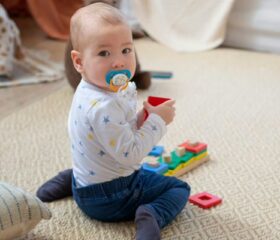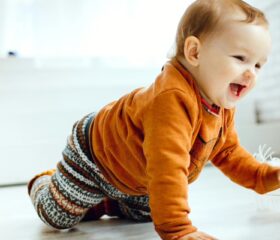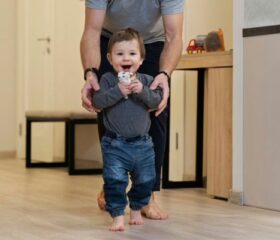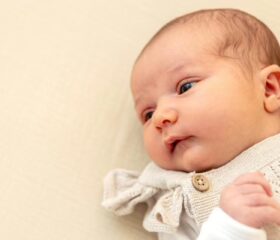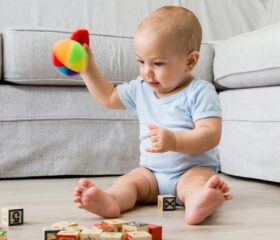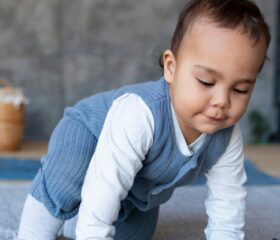Baby Month by Month
9-Month-Old Baby
Your baby can now sit up (and stay there) by himself.

As your baby starts crawling or even taking a few wobbly steps, he’ll become more of an active explorer than just a passive observer. He’s probably starting to “talk” more and show off his personality.
Read on to find out more about what you can expect from your 9-month-old, along with a few useful tips to take care of him.
Your baby’s development at 9 months
Your baby is making great strides in his development at 9 months. Here’s what you can expect from his development.
Physical development
Your baby has mastered several physical skills by now, and he’s practicing many others. This is what he’s up to at 9 months:
- Sitting: Your baby can now get into a sitting position all by himself and sit without any support. 1 If you’ve been eager to take your baby on the swings at your local park, now’s your chance, as long as you pick baby-safe (bucket) swings.
- Crawling: Many babies are great crawlers at this stage. Yours may try out a handful of different crawling styles, like traditional hands-and-knees crawling, army crawling, or scooting. 2
- Pulling to stand: You may catch your baby using your legs, furniture, or other large objects to pull himself up to a standing position. If he’s developed this skill, he should be able to sit down from a standing position, too. 2
- Move things between hands: You’ll see your baby transferring toys and other objects smoothly from one hand to the other. 1
- Use his fingers: Your baby can use his fingers to scrape food on the table toward him. He may also use his thumb and index finger to pick up small objects (known as the pincer grasp). 13
- First steps: Most babies won’t walk well until they’re 12–15 months old. However, your baby may attempt to balance while standing on his own and walk with (or even without) assistance. 42
Cognitive and language developments
Aside from his physical milestones, there’s a lot going on inside your baby’s brain. This month, his cognitive and language development are skyrocketing, and you may see him hone in new skills like:
- Understanding simple commands: He might respond to one-step instructions, especially if you pair them with gestures. For instance, he may understand if you say “Give me the ball” with your hand stretched out.
- Babbling and early words: Your baby’s babbles might sound more like actual words, such as “mama,” “dada,” or “bye-bye.” Even if he’s not speaking clearly yet, he understands more words than he can say. 1
- Understanding cause and effect: He probably likes to play with toys that show cause and effect, such as buttons, levers, and doors. This shows he’s learning how his actions can affect the world around him.
- Tracking moving objects: He may trace moving objects with his eyes, such as watching an object fall from the table. If he sees you hide an object, he may look for it. 3
Moreover, your baby has a better memory now. 5 He may remember where certain toys are or imitate actions he’s seen you do.
Emotional and social developments
As your baby learns how to express himself better, you’ll get to know more of his personality. You may also notice a broader range of emotions in his actions.
Check out how his emotional and social developments are coming along:
- Testing boundaries: While your baby might understand what “no” means by now, that doesn’t mean he’ll always behave. He may bang toys on the floor, throw food, or try to get a reaction out of you in other ways. This behavior allows him to experiment and learn what actions are acceptable.
- Attachment: Your baby’s separation anxiety is at its peak, and he’ll probably cling to you more than ever. To help him cope, give him short and sweet goodbyes and stick to a predictable routine. 1
- Fear of strangers: Not only will he cling to you, but he may be shy or even afraid of strangers. Be patient and introduce him to new people slowly to help him overcome his fear.
- Reacting and making facial expressions: You’ll see more reactions and facial expressions from your baby at 9 months. For example, he may look at you when you call his name, cry when you leave the room, and laugh when you play with him. 1
- Communication: Your baby may communicate with you using various gestures, sounds, and facial expressions. For instance, he might lift his hands if he wants you to pick him up. 1
Your baby’s feeding milestones at 9 months
You may notice that your baby’s appetite is growing. While he should already be eating solid food at 9 months, he’ll still need at least 4–6 breastfeeding sessions or 4–5 formula feedings (6–8 fluid ounces per formula feeding) a day. 6
Getting your baby used to solids
As mentioned, your baby is well into his solid foods foray. Keep feeding him pureed foods while adding some mashed and ground foods to his meals, too.
Here are some common foods and the per-day amount you can feed them to him: 6
| Food | Recommended serving per day |
|---|---|
| Baby cereal | 4–8 tablespoons or more |
| Other grains (oats, rice, quinoa, grits, noodles, whole wheat toast, or soft tortilla pieces) | 0.25 cups twice a day |
| Vegetables | 0.25–0.5 cups 2–3 times a day |
| Fruits | 0.25–0.5 cups 2–3 times a day |
| Pasteurized dairy (yogurt, cottage cheese, or small, thin slices of cheese) | 0.25 cups 1–2 times a day |
| Protein (cooked lean meat, chicken, turkey, beans, fish, eggs, or tofu) | 0.25 cups 1–2 times a day |
If your schedule allows, consider feeding your baby while the rest of the family eats. Doing so may make your baby more willing to try out different foods. 6
Make sure your baby is drinking enough water
If your baby is eating many different types of food, you need to give him around 4–8 fluid ounces of plain water per day. In some cases, he might need more than that. Ask your doctor exactly how much water you should give him if you’re unsure.
What is baby-led weaning?
Baby-led weaning (BLW), or “auto-weaning,” is a popular self-feeding method. Many parents use it to gently and gradually move their baby from drinking exclusively milk or formula to eating solids.
With BLW, instead of feeding your baby specially pureed or mashed-up foods, you’ll give him small (safely cut-up) portions of whatever the rest of the family is having. The idea is to allow your baby to feed himself and eat however much he wants.
It’s best to do this while your baby is sitting at the table beside the rest of the family. 78
Your baby’s sleep patterns at 9 months
Most 9-month-old babies start sleeping through the night for up to 8–10 hours without waking up to feed. But even if your baby still wakes up during the night, he’ll soon learn how to soothe himself back to sleep without your help. He may also take 1–4 naps ranging from 30 minutes to 2 hours every day. 9
What if your baby has trouble sleeping?
At this stage, your baby may have sleep disruptions due to teething, making developmental leaps, and separation anxiety at night. These factors can trigger a sleep regression, which is when a baby who once slept soundly suddenly has trouble sleeping or resists naps and bedtime altogether.
You can combat his sleep regression by sticking to a consistent bedtime routine. Try singing him a lullaby or rocking him to signal it’s time to sleep, as well as putting him down for bed the same time each night.
If your baby has separation anxiety, speak to him calmly and rub his head or back, but don’t take him out of bed. Quietly leave the room once he’s calmed down. 9
Tips to keep your 9-month-old healthy and safe
With a 9-month-old crawling all over the place, now’s the time to be extra vigilant about his safety.
Keeping your baby safe at home
If you haven’t already, babyproof your entire house. You can check by crawling on your hands and knees to spot potential hazards (e.g., sharp furniture edges) you might not notice when standing.
You should also:
- Keep small objects out of sight: Keep any small objects like coins, buttons, and batteries out of your baby’s reach. Now that he has better control of his fingers (and a penchant for putting anything in his mouth), he can pick up tiny objects and stuff them into his mouth.
- Be careful with bathtime: When you give your baby a bath, never leave him unattended, even for a moment. Accidents can strike in a matter of seconds, and you never know when they’ll happen.
- Check your baby’s car seat: Make sure your baby’s car seat still fits him. Check the weight limit on his seat. If he’s too big for it, it’s time for an upgrade.
Moreover, when you take your baby outside, make sure he’s wearing an infant-safe sunscreen. Mineral sunscreens, such as those containing zinc oxide or titanium oxide, are the safest option, as they don’t get absorbed by your baby’s skin. 10
However, that doesn’t mean you should forget other sun-protection methods, like wide-brimmed hats.
Your baby’s 9-month well-baby visit
Another well-baby visit is coming up this month. Here’s what you can expect from this check-up:
- Growth monitoring: Your doctor will track your baby’s weight, length, and head circumference to check that he’s growing as expected.
- Developmental milestones: Your doctor will also check if your baby is hitting key milestones, such as crawling, pulling up to stand, and babbling. They may have you play with your baby while they observe.
- Screenings: If there are reasons to believe your baby has health issues like anemia, lead poisoning, or developmental delays, your doctor will give him a thorough screening.
- Vaccine check: If your baby didn’t get his last dose of the hepatitis B vaccine (HBV) or his third dose of the inactivated polio vaccine (IPV), he’ll get them at this check-up. The American Academy of Pediatrics (AAP) also recommends that all babies 6 months old and above get a flu shot when it’s available. 11 This is around when he might be up for a COVID-19 shot, too.
- Oral hygiene: Your doctor may apply fluoride varnish, a type of dental treatment to prevent tooth decay, to your baby’s teeth (if he has any). 11
As usual, this is a good time to discuss any concerns you have about your baby’s sleep, feeding, or behavior with your doctor.
You also shouldn’t hesitate to bring up any other issues your baby has been dealing with, such as skin problems like diaper rashes, eczema breakouts, or persistent flakes on his scalp (cradle cap).
Activities to do with your 9-month-old
Don’t discount the importance of playtime! Playing and interacting with your baby will help him build his physical, cognitive, emotional, and social skills.
Making playtime fun and engaging for your baby
Give your baby age-appropriate toys with different textures, shapes, and sounds to stimulate him. It’s a good idea to rotate his toys regularly so that he doesn’t lose interest in them quickly.
Specifically, let him play with toys that involve pushing, pulling, or opening to learn cause and effect. Musical toys and baby-safe art supplies are also great options, as they can help him tap into his creative side.
Encourage him to crawl, pull to stand, and do other physical activities, such as playing with balls or soft blocks.
Encouraging your baby’s language development
For his language development to soar, try singing songs, reading books, and even just talking to him. Though he might not understand everything you say right now, little by little, he’ll pick up more words and sentences until he can really talk your ear off.
Final thoughts
Entering month nine is a huge step for both you and your baby. Your 9-month-old can certainly be a handful at times, but enjoy his new bursts of energy and mobility. Take his increased awareness, boundary pushing, and adorable babbles as proof that you’re doing a great job in helping him excel.
Article Sources
- U.S. Centers for Disease Control and Prevention. "Important Milestones: Your Baby By Nine Months" Retrieved July 17, 2025.
- MedlinePlus. "Infant - newborn development" Retrieved July 17, 2025.
- State of Michigan. "Milestone Checklist 9 Months" Retrieved July 17, 2025.
- MedlinePlus. "Toddler development" Retrieved July 17, 2025.
- Zero to Three. "9–12 Months: Your Baby’s Development" Retrieved July 17, 2025.
- Florida Health. "Food for Baby's First Year" Retrieved July 17, 2025.
- American Academy of Pediatrics. "Baby-Led Weaning: Is It Safe?" Retrieved July 17, 2025.
- WIC South Dakota. "Baby-Led Weaning" Retrieved July 17, 2025.
- MedlinePlus. "Bedtime habits for infants and children" Retrieved July 17, 2025.
- Cleveland Clinic. "Sunscreen for Babies: When Can You Use Sunscreen and What Kind Is Safest?" Retrieved July 17, 2025.
- American Academy of Pediatrics. "Checkup Checklist: 9 Months Old" Retrieved July 17, 2025.
